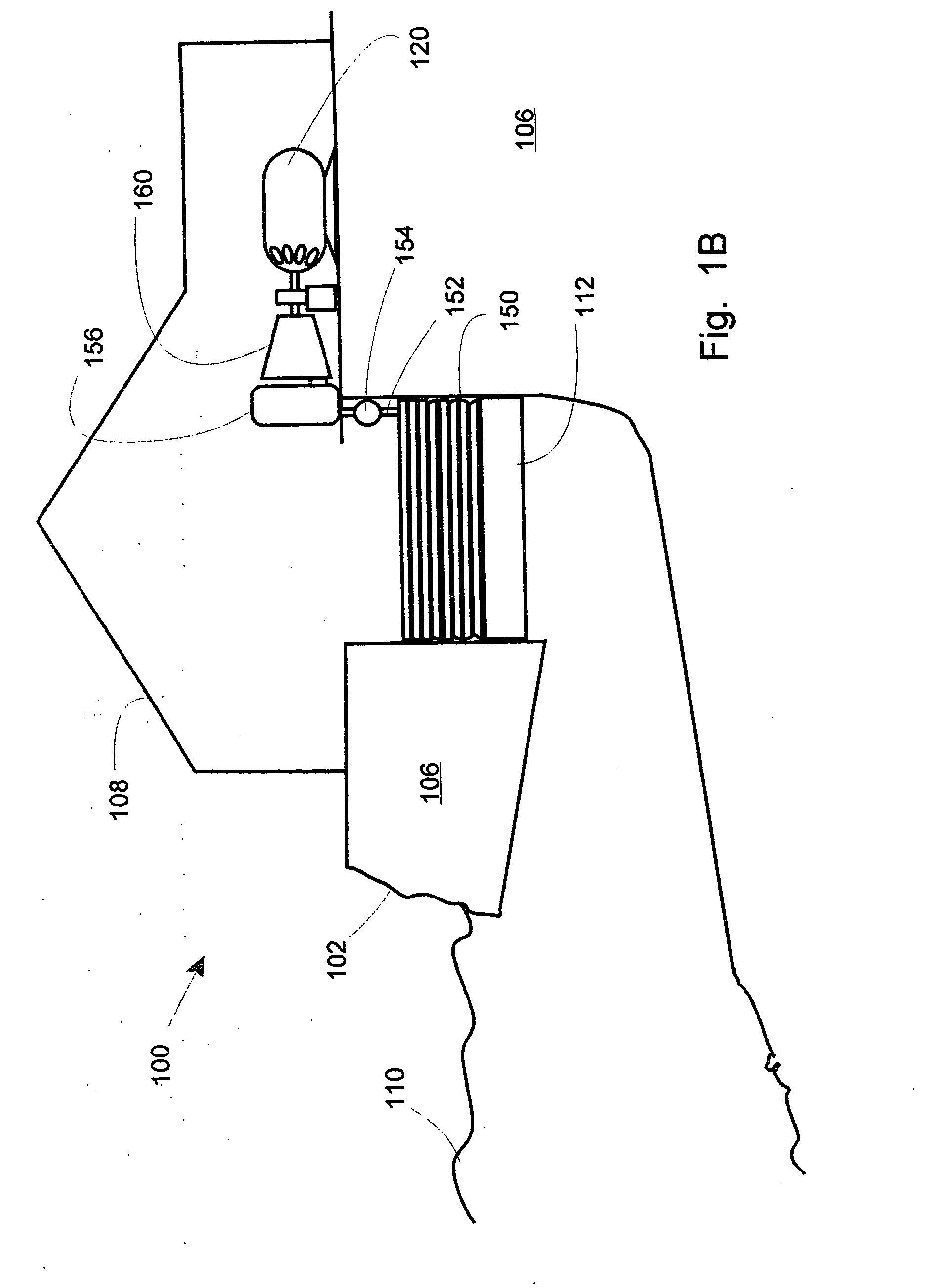Apparatus for converting ocean wave energy to electrical energy
a technology of electrical energy and apparatus, applied in the field of wave energy, can solve the problems of large cost and effort, complex structure, and large cost of electricity generation
- Summary
- Abstract
- Description
- Claims
- Application Information
AI Technical Summary
Benefits of technology
Problems solved by technology
Method used
Image
Examples
second embodiment
[0099]FIG. 1B is a partially cross-sectional side view of an alternative second embodiment of the invention using a bellows, air reservoir, and a turbine. Wave energy generator 100 is situated on coast 102 and has been provided with bore 104 by means of drilling, blasting, mining, construction or even backfilling and the creation of an artificial coast. Coast substrate 106 has shelter 108 (if necessary) atop it. Ocean / waves 110 may freely enter the bore 104 and thus raise and lower float piston 112 between first and second positions.
[0100]In this alternative embodiment, bellows 150 connects to air conduit 152 which may have valve 154 therein, and may connect to compressed air reservoir 156 which in turn feeds compressed air to turbine 160. In this embodiment, the flywheel may be omitted as the use of compressed air reservoir 156 may allow an even flow of air to the turbine and thus an even rotation of the shaft. Electrical generator 120 may also be a type which operates well despite...
third embodiment
[0105]FIG. 2 is a partially cross-sectional side view of an alternative “float” third embodiment of the invention using a ratchet and chain, and a flywheel.
[0106]Wave energy electricity generation facility 200 may be located on coastline 202 as previously described. Bedrock 206 may in some instances serve as an ideal substrate through which the bore is driven. Building 208, waves 210, reciprocal / rotary motion converter 236, and flywheel 218 as well as generator 220 may also be as previously discussed.
[0107]Bore spacer 232 having cross brace 234 may be used with this “float” embodiment to provide a filled in space within the bore. Reciprocal / rotary motion converter 236 may be part of the space 232 and may carry upon it the chain and sprocket mechanism of the converter discussed in reference to FIGS. 3A and 3B.
fourth embodiment
[0108]FIG. 4 is a partially cross-sectional side view of an alternative fourth embodiment of the invention using a ratcheted piston rod, elongated shaft, and flywheel. Wave energy facility 400 on coast 402 has bore 404 through substrate 406 covered by shelter 408.
[0109]Motions of large body of water 410 may move float 412 between two or more positions, which in turn moves rod 414, which may have a worm drive or cog drive to elongated shaft 416 bearing flywheel 418 and providing mechanical power to generator 420.
[0110]Such an elongated shaft 416 may be less preferable, due to weight, momentum and power restrictions.
[0111]Safety barrier 422 may be provided across the wave race or bore so as to prevent accidental or deliberate ingestion of human beings or wildlife into the mechanism. In embodiments, the bore diameter may be quite large.
[0112]Bore diameter 424 and throw 426 may vary considerably. Thus extremely small shafts and throws of inches in diameter / length may be used, while in o...
PUM
 Login to View More
Login to View More Abstract
Description
Claims
Application Information
 Login to View More
Login to View More - R&D
- Intellectual Property
- Life Sciences
- Materials
- Tech Scout
- Unparalleled Data Quality
- Higher Quality Content
- 60% Fewer Hallucinations
Browse by: Latest US Patents, China's latest patents, Technical Efficacy Thesaurus, Application Domain, Technology Topic, Popular Technical Reports.
© 2025 PatSnap. All rights reserved.Legal|Privacy policy|Modern Slavery Act Transparency Statement|Sitemap|About US| Contact US: help@patsnap.com



